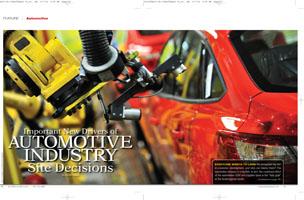
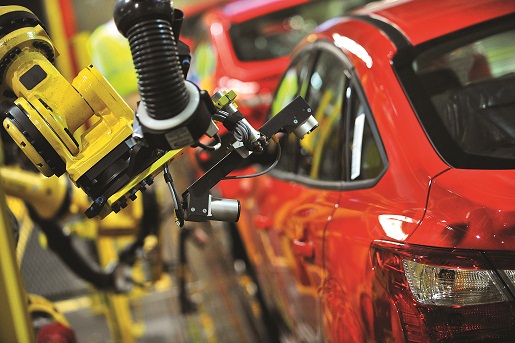 |
| Photo courtesy of Ford Motor Company |
Everyone wants to land the proverbial big fish in economic development, and who can blame them? The automotive industry is a big fish. In fact, the combined effect of the automotive OEM and supplier base is the “holy grail” at the local/regional levels.
This knowledge should not be lost on executives involved in the site selection process for OEM’s or suppliers. States and communities are keen to recruit this industry and will go to great lengths to do so; however, they too understand that there is a process and methodology that defines their competitiveness.
Both the site selection executive and the economic developer will perform a thorough examination of the geographic locations of OEM assembly plants and their respective suppliers. This investigation will quickly indicate the likelihood of where an OEM can expect to be successful by indicating the inherent competitive advantages.
Next, an assessment of the level of commitment demonstrated and a willingness to create a truly competitive environment must be quantified and qualified.
Finally, an understanding of the key drivers affecting the automotive industry now and in the future will provide a leverage point if and when earnest negotiations begin. The industry has changed, and along with it, so has the strategy to recruit.
Automotive Industry Changes
It is no secret that the automotive industry has been under intense pressure the last few years. The loss of domestic market share in the U.S. market to foreign companies is of great consequence. This trend will likely continue as international companies capitalize on the uncertainty in the U.S. market, while using the dollar as a hedge against fluctuations in their own currencies at home. Nevertheless, there have been bright spots with regard to innovation and market response lately from U.S.-based companies – particularly Ford Motor Company.
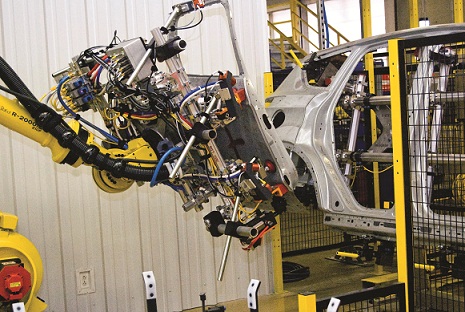 |
| Louisville Assembly Plant: New robotic equipment at the Louisville Assembly Plants improves plant efficiency and boosts quality. |
Of course, the pace with which large automotive OEMs move is far different than other industries. They are not able to turn on a dime like the software industry. While designing vehicles can be done very quickly these days, the effort to retool factories for new technologies is no small undertaking. Further compounding the situation is the fact that the price of raw materials increased almost 50 percent in the past few years as well as the demand of high- technology equipment offerings.
Competitor Proximity Trend
In the past, OEMs were not averse to being in close proximity to other OEMs. The availability of labor was abundant, the supplier base was concentrated and the work practices of auto manufacturers were very similar. However, this changed with the introduction of foreign competitors from Japan and Germany that wanted to institute a different approach to manufacturing and labor relations. Because of their desire to have maximum flexibility regarding work rules (non-union), they decided to establish manufacturing operations far away from the traditional auto manufacturing region in the Great Lakes area. This trend has continued ever since, and one would be hard pressed to find auto OEMs within 100 miles of each other. Why? Because each OEM wants to avoid being in a competitive hiring situation, and they want their workforce culture and practices to remain their own. While there are always exceptions to every case, in general, if you are within 100 miles of an existing OEM, you should not consider this a viable location. As a site selection executive, this concept is straightforward.
From another perspective, as an OEM, you will not want to stray too far from your supplier base–unless there are compelling reasons to pursue a specific market segment and grow/recruit the supply chain.
On the other hand, if you are a supplier, then proximity is not so much of an issue. While some OEMs have a strong desire to have Tier 1 suppliers on (or virtually adjacent to) the plant site, others are content to have them within a reasonable distance of 50 miles for just-in-time deliveries. If this is the case, then there are definite advantages to being within a 100-mile proximity to OEMS. Tier 2 suppliers have a greater degree of flexibility when it comes to location and are not as concerned with proximity to other suppliers as they are to competition for skills and higher wages.
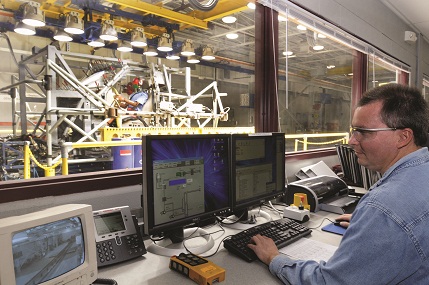 |
| A test technican prepares the Servo Sled for testing. The Servo Sled is shown testing simulated frontal impact at Ford's Safety Innovation Lab. Photo by Sam Varnhagen/Ford Motor Co. |
Being Prepared Matters
A typical automotive design cycle is approximately 24 to 36 months, which is much faster than the 60-month life cycle from five to 10 years ago. Automotive design has moved toward the “platform” concept, which means car models along similar configurations are now provided with one basic design (platform) with differentiation between products provided by add-on equipment, stamped panel styling and custom interiors. In short, two to three years have been cut out of the design cycle. This has occurred not only because current technology allows it to happen, but also because the consumer market demands it.
What does this mean for those for those involved it heading up a site selection endeavor? Quite simply, it means that for a potential site to be considered, the site must be ready immediately. Immediately does not mean in six months, three months or even a month. It means that when your company decides to locate in a community you have the ability to begin construction as fast as possible. As the person responsible for hundreds of millions of dollars of investment, it is important to understand the difference between promises and execution plans in action—these are not the same.
What does ready for development mean? There is no one, single definition of a project-ready site, and there are varying degrees of “readiness” according to whom you ask. In addition, what one industry may require in a site might not be relevant for another industry. Generally speaking, however, a project-ready site must have the following characteristics:
The site is available. This means the site is truly for sale, preferably with established terms and conditions. Additionally, ownership or a clearly defined option is provided. An acceptable alternative would be long-term, renewable, assignable option agreements with land owners on key parcels.
The site is fully served. Ideally all utilities (water, sewer, electric, natural gas, etc.) are at the site with appropriate sizes and capacities. If the utilities are not at the site, the community should have developed detailed plans with service providers to extend and/or upgrade utilities. These plans should include appropriate rights-of-way studies and detailed cost and schedule estimates.
 The site is developable. Sites that are developable have no significant easements or rights-of-way impinging on the development, and they have all necessary due diligence (i.e., environmental assessments) completed as well as any necessary mitigation completed. If there are utility easements on site, the community should be prepared to present detailed plans on the ability and willingness to move those utilities, providing details on cost and schedule.
The site is developable. Sites that are developable have no significant easements or rights-of-way impinging on the development, and they have all necessary due diligence (i.e., environmental assessments) completed as well as any necessary mitigation completed. If there are utility easements on site, the community should be prepared to present detailed plans on the ability and willingness to move those utilities, providing details on cost and schedule.
From an OEM’s perspective, the availability of a project-ready site is a criterion that must exist to be a candidate for consideration. If the site you are considering is a project-ready site, then the site should be eligible for further consideration for the next level; if not, dismiss the site and move on to the next one. Fortunately, there are enough certified sites in the U.S. these days that this is possible in contrast to even a decade ago.
Important Drivers
Probably the most important driver is the availability and quality of a skilled workforce, both now and in the future. It may surprise some that manufacturing costs or business climate are not the most important drivers because they are indeed very important considerations; however, labor quality and productivity are by far the most important factors. Consider the cost structure of an OEM’s manufacturing. Wages constitute only 5.7 percent of the total cost. So the erroneous belief that OEMs are looking for low-wage-cost areas demonstrates a lack of understanding of the importance of workforce flexibility and adaptability. Translated, this means a lack of work rules associated with strict union contracts that stifle productivity and inhibit innovation. While it may not be a popular statement on my part, it is what it is, and Indiana, a newly converted right-to-work state, will probably see results very quickly.
 |
| General Motors broke ground on a new $200 million stamping facility at the Arlington manufacturing complex in Arlington, Texas. The new stamping facility could add 180 jobs while producing large, metal stampings for doors, hoods and side panels in the next generation of the full-size SUVs built at GM Arlington - the lone source for Chevrolet Tahoes, Suburbans, GMC Yukons and Cadillac Escalades sold globally. Photo by Tim Sharp for General Motors. |
Important elements in workforce quality include not only the existing educational infrastructure in K-12, vocational/technical schools, community colleges and universities, but also the degree with which there exists cooperation between these institutions and industry. Examples include high-school-to-work programs that embody an apprenticeship program in the 11th and 12th grades as opposed to placing this burden on the company. Science, Technology, Engineering, and Mathematics (STEM) fields have become increasingly central to U.S. economic competitiveness and growth—although there is more talk than action taking place in most communities.
In addition, a commitment to assist in the recruitment and training of workers for plant start-up, growth and subsequent expansions through state training programs is essential. Only a few states do a very good job of explaining the process of recruiting, screening, pre-employment training, post-employment training, staffing and funding. The states that do a good job not only discuss the funding for the program and the value it provides for the company, but also lay out the entire process starting with advertising and recruiting all the way through to delivery of post-employment training. Staffing, schedule, action items and the entire process should be laid out in a manner that is easily understood to prospects.
From a supplier perspective, workforce quality and skills are important, but other issues should be considered as well. There are some general trends to consider when suppliers are evaluating different locations. Some are the consequence of the competitive environment, while others are activities that are a unique collaboration between the demands of the OEM and a market response of the public/private sectors, as follows.
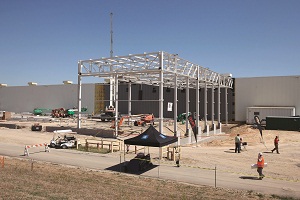 |
| Framing for a body shop expansion at the General Motors Arlington in Arlington, Texas. The expansion was part of a $331 million investment in the plant. Photo courtesy of General Motors. |
• Proximity to interstate systems (or highways of comparable quality) with quick, efficient access to the assembly plant can mitigate the need for adjacent location to OEMs of many Tier 1 suppliers – sometimes a preference for the supplier, though not always the OEM.
• Automotive business parks provide a distinct advantage for those suppliers that produce complex modules with intense just-in-time requirements in close proximity to the OEM.
• Excellent transportation infrastructure for suppliers, with an emphasis on time-of-delivery considerations.
• Components that require more labor and less sophisticated technology will grow fastest abroad and depart North America. Complex manufacturing will favor those locations that have quick start-up capabilities (i.e., skills, training, certification, buildings, sites, etc.).
• Product life cycles are shorter than ever and will continue to speed up—reducing time to market includes available sites and buildings, out-of-the-box thinking regarding specific customized training, and R&D capabilities outside of Detroit. Supplier integration into the Product Life-Cycle Management process is increasing.
• Cost pressure to the supplier means every production input counts—mitigating not only development costs, but ongoing operating costs such as utilities, taxes, etc.
Summary
Vehicle sales have decreased dramatically over the past five years but are rebounding steadily. The result is a contraction in production and even plant closing with domestic manufacturers. The internationals seem to be maintaining and are expanding in most cases. Trying to anticipate whether an OEM will produce a new product line using hybrid, EV or other technology will probably be more important at the legislative level for special incentives than at the local level as a recruitment strategy, and influencing this legislation should be considered part of the OEM/supplier’s negotiation strategy. However, there is no discounting the synergies that can occur between a university and company collaboration.

